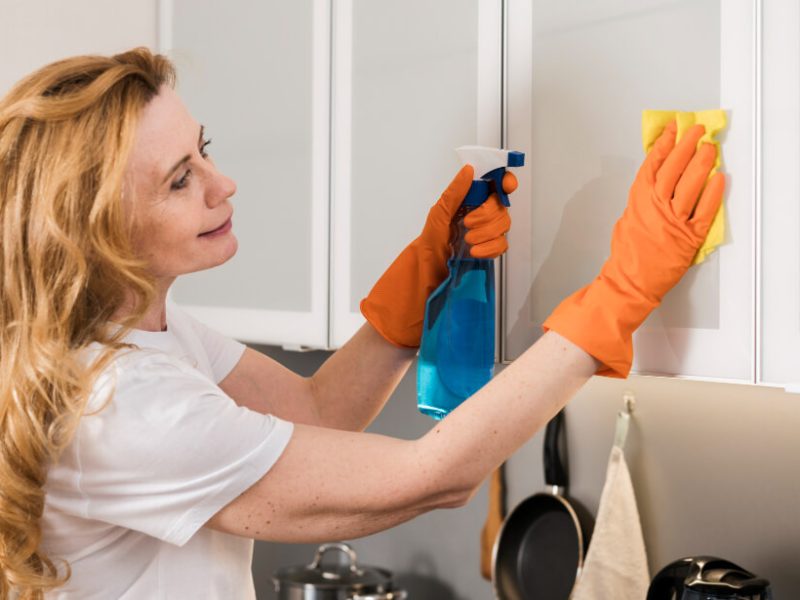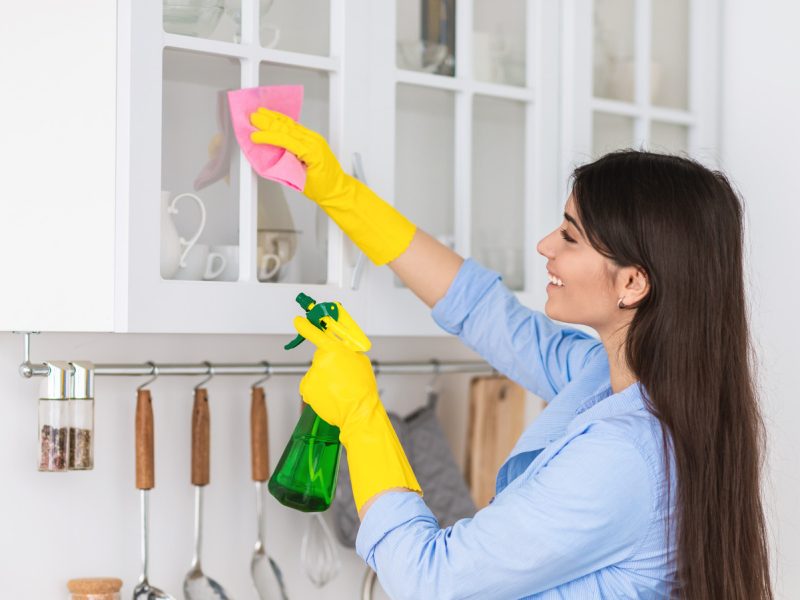Cleaning the kitchen sink is an important part of keeping your kitchen and home hygienic and free of bacteria. It is also important for maintaining the appearance of your kitchen. This guide will walk you through how to properly clean and maintain your kitchen sink so it stays looking and smelling fresh. You will learn the best cleaning products and techniques to use and how often to clean for optimal results. With the right care and maintenance, your kitchen sink will remain clean and hygienic for years to come.
Necessary Supplies
Cleaning the kitchen sink can be a daunting task, but with the right supplies, it doesn’t have to be. To make sure the job is done properly, you’ll need a few essential items to get the job done. A good cleaner, a sponge, and a scrubber are all must-haves for cleaning the kitchen sink. A cleaner with disinfectant properties is great for removing grease, dirt, and grime, while a scrubber will help remove any tough stains or spots. A sponge, on the other hand, is perfect for polishing the sink and ensuring that it looks as good as new. Once you’ve gathered the right supplies, you can get to work on cleaning the kitchen sink.
Pre-Cleaning Preparation
Pre-Cleaning Preparation is the first step in cleaning your kitchen sink. It is important to clear away any debris, food scraps, and other items that can accumulate in the sink. This will make it easier to thoroughly clean the sink and prevent any unnecessary damage. Start by removing the drain stopper or strainer to get rid of any debris. You can use pliers or a screwdriver to loosen any screws that hold them in place. Next, use a brush or scraper to remove any food scraps or soap scum that may have built up. Finally, wipe off the sink basin with an all-purpose cleaner to prepare it for the next step. Taking the time to properly prepare the sink for cleaning will make the process easier and ensure that your kitchen sink is clean and sparkling.
Clearing Clogs and Blockages
Clogged and blocked kitchen sinks can be a nightmare for any homeowner. Whether it’s food particles, grease, or hair, these blockages can be difficult to remove. Fortunately, there are several simple steps you can take to unclog and clear your kitchen sink.
Start by filling the sink with hot water and adding a cup of baking soda and a cup of white vinegar. This will create a fizzy reaction that can help to break down and dissolve any debris that is blocking the drain. Wait for 15 minutes, then plunge the sink with a plunger for several minutes to help clear the blockage.
If the clog persists, try using a drain snake. Retrieve the snake from the drain, and then insert it into the drain. Move the snake back and forth until the clog is loosened, and then pull the snake out of the drain.
Finally, if the clog is still not cleared, you may need to use a chemical drain cleaner. Be sure to read the labels of the cleaner carefully, as some chemicals can be harmful to pipes and surfaces.
Cleaning the kitchen sink can be a challenging task, but following these simple steps can help clear clogs and blockages quickly and efficiently.
Removing Stubborn Stains
Removing stubborn stains from your kitchen sink can be a daunting task. With the right approach and the right tools, however, it can be done. For tougher stains, start by using a commercial cleaner or a paste of baking soda and water. Scrub the paste in circles, using a non-abrasive scrub pad or brush. After scrubbing, rinse the sink with warm water and dry it with a soft cloth. For more persistent stains, use a cleaner specifically formulated for removing rust, lime, calcium, or other mineral deposits. Apply the cleaner to a damp cloth and rub it in circles until the stain is gone. Rinse the area with warm water and a soft cloth. For tougher stains, consider using a pumice stone or steel wool to gently scrub away the stain. Finally, rinse the sink with warm water and dry it with a soft cloth. With these steps, you’ll be able to remove even the most stubborn stains from your kitchen sink.

Cleaning and Sanitizing
Maintaining a clean and sanitized kitchen sink is essential for any home. Not only does it help keep your kitchen looking its best, but it also helps prevent the spread of germs and bacteria. Learning how to properly clean and sanitize your kitchen sink can help ensure that your kitchen is a safe and healthy environment.
The first step to cleaning a kitchen sink is to remove any debris, food particles, or other objects from the sink. This can be done using a sponge or cloth, or even just your hands. Make sure to get into all the nooks and crannies of the sink, and be sure to scrub along the edges and corners.
Once the sink is free of debris, it’s time to tackle the dirt and grime. Use a mild dish soap and a soft sponge or cloth to scrub the entire sink, including the faucet and drain. Rinse off the soap with warm water.
Now that the sink is clean, it’s time to sanitize. Use a solution of one tablespoon of bleach mixed with one gallon of water. Soak a cloth with the mixture and use it to wipe down the entire sink. Allow the solution to sit on the sink for five minutes before rinsing it off.
Finally, dry the sink with a clean cloth and you’re done. Cleaning and sanitizing your kitchen sink is an important task that should be done regularly. Doing so will ensure that your kitchen is clean and hygienic, and also helps to prevent the spread of germs and bacteria.
Sealing and Protecting
Having a clean and orderly kitchen sink is essential for a healthy home. But it’s not enough to just wipe down the surface. To ensure a long-lasting clean sink, you must also seal and protect it. Sealing and protecting your sink is an important step that will help keep it looking new for years to come.
To begin, you’ll need to make sure that all of the surfaces are clean before you begin the sealing process. Once the sink is completely dry, you can start applying a sealant to the surface. A sealant will help keep moisture out and protect the sink from scratches, stains, and other damage. Be sure to follow the instructions on the sealant package for the best results.
Once the sealant is applied, you’ll want to use a soft cloth to buff it out until it has a nice glossy finish. This will help it to last longer and will help keep it looking brand new. If you find that your sink is still not sealed properly, you can apply a second coat. Just be sure to follow the instructions on the sealant package for the best results.
Finally, you can add a layer of protection to your sink by using a sink mat. This will help keep your sink looking clean and can also protect it from being scratched or damaged. A sink mat is an easy and affordable way to keep your sink looking its best for years to come.
Sealing and protecting your sink is an important part of any kitchen cleaning routine. By taking the time to properly seal your sink, you’ll be able to enjoy a clean and organized kitchen sink for years to come.
Maintenance Tips
Maintaining a clean and well-functioning kitchen sink is essential for a healthy home. Keeping your sink clean and properly sanitized not only looks better but also helps prevent germs and bacteria from spreading. But without regular maintenance, your kitchen sink can quickly become a mess. Fortunately, there are some simple tips that can help you keep your kitchen sink looking its best.
First, make sure to regularly clean and scrub the sink. Use a mild detergent and sponge to remove any build-up of food or grime. Pay special attention to the faucet and drain, as these are often the most difficult areas to clean. Rinse the sink thoroughly with warm water afterwards.
Second, use a good disinfectant to kill any bacteria or germs that may be present. There are many commercial cleaners designed specifically for cleaning kitchen sinks, but you can also use a diluted solution of bleach and water. Make sure to rinse and dry the sink thoroughly afterwards.
Third, use a sealant to protect the surface of the sink. This will help keep dirt and grime from penetrating the surface and keep your sink looking great. You can purchase sealants specifically designed for kitchen sinks at any home improvement store.
By following these simple tips, you can keep your kitchen sink looking clean and functioning properly. With regular maintenance, your kitchen sink will remain in great shape for years to come.
Troubleshooting Common Issues
Cleaning a kitchen sink can be a tricky task. With a few simple steps, however, you can troubleshoot common issues that may come up. The first step is to identify the problem: is there a clog in the drain or a buildup of gunk and grime on the surface? If there is a clog, you can try any number of solutions, such as a plunger, a drain snake, or a chemical drain cleaner. If the problem is a build-up of grime and gunk, you can use a scrub brush and a cleaning solution to get rid of it. For more difficult stains or odors, you may need to use a more powerful cleaning solution. Once you’ve identified the problem and taken the necessary steps to address it, you can move on to the next step. This involves regular maintenance, such as wiping down the sink after each use and running a solution through it on a weekly basis. With these steps, you can keep your kitchen sink looking and smelling its best!
Conclusion
Overall, cleaning the kitchen sink is an important part of maintaining a healthy and safe kitchen environment. By regularly cleaning the sink with water, baking soda, and vinegar, you can easily and effectively remove dirt, grime, and bacteria. Additionally, using a scrub brush and other cleaning tools helps to ensure that the sink is clean and free of food debris and other contaminants. Finally, it is important to make sure the sink is dried thoroughly after each use and to seal any cracks and crevices to prevent future build-up. With these simple steps, you can ensure your kitchen sink is clean and safe for food preparation.


